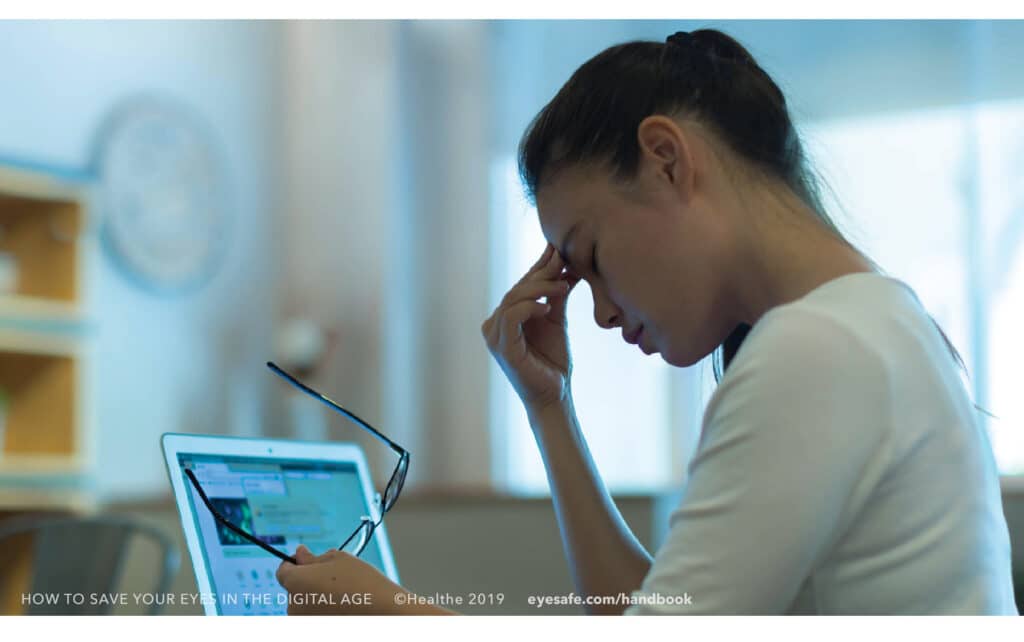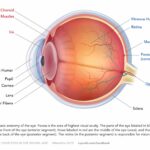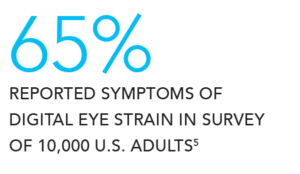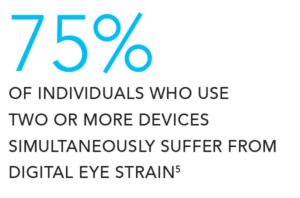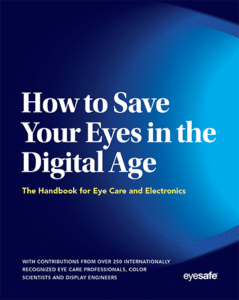How to Save Your Eyes in the Digital Age
The Handbook for Eye Care and Electronics
WITH CONTRIBUTIONS FROM OVER 250 INTERNATIONALLY RECOGNIZED EYE CARE PROFESSIONALS, COLOR SCIENTISTS AND DISPLAY ENGINEERS
SECTION 1: HOW BLUE LIGHT AFFECTS THE EYE AND BODY / CHAPTER 3
Digital Eye Strain
At its simplest, digital eye strain is eye and vision-related, caused by spending extended periods of time on computers, tablets, smart phones, or gaming consoles.
There is a good correlation between the number of digital devices someone owns and the amount of time spent using them. In some cases, extensive daily use is common (spending 8+ hours on a computer at work, then another few on a tablet or smartphone or gaming consoles during “off” time).1 Further, digital device use has broken all age barriers—grandparents use their devices to communicate with grandchildren, and younger people use tablets to read or play games. Even preschool children regularly use digital devices.
While the device of choice may differ (older people tend to prefer laptops and desktop computers for surfing the Internet, while younger people tend to prefer smartphones), social media use and multitasking on multiple devices simultaneously is commonplace among people under thirty.
With this increasing reliance upon digital devices comes an increasing percentage of people with vision complaints directly related to their digital device use. Complaints typically fall into two categories: vision problems (where the screen becomes more difficult to focus on), and abnormal sensations (i.e., dry eye). For some, these symptoms will be transient in nature but for others, symptoms will be frequent and persistent to the point of seeking medical attention.
Digital Eye Strain
The above phenomenon has been a recognized health issue for the past twenty years. Originally called “computer vision syndrome,” the introduction and rapid acceptance of digital devices has broadened the overall category to be renamed “digital eye strain.”1
At its simplest, digital eye strain is eye and vision-related, caused by spending extended periods of time on computers, tablets, smart phones, or gaming consoles. In more technical terminology, digital eye strain “is a condition characterized by visual disturbance and/or ocular discomfort related to the use of digital devices and resulting from a range of stresses on the ocular system, including glare, defocus, accommodation dysfunction, fixation disparity, dryness, fatigue and discomfort.”2
One key point, however, is that signs and symptoms do not always correlate. For instance, external symptoms (such as a burning sensation, or irritation and tearing, or dryness) are all closely related to dry eye, but vision/internal symptoms (such as eye strain, or headaches behind the eyes) are linked more to vision stress.1
Digital eye strain is now being considered an emerging public health issue, and its effect on vision cannot be overlooked.2
Anatomy of the Eye
To understand how digital eye strain affects vision, a basic understanding of the anatomy of the eye is warranted. The eye is responsible for the detection of visible light; for humans that range is about 400 to 700 nm. This organ must be able to address all the optical requirements of imaging, while concurrently being able to readjust and optimize the parameters across the entire range of visible light and ideally at any distance.3 And it does so with only about one-sixth exposed and easily seen (the remainder is protected by orbital sockets in the skull).
As shown in Figure 3-1, the retina is the innermost layer of the eye, and lines three quarters of the back of the eye. It is where the visual pathway originates, and is often compared to a camera. The retina is considered the “photographic film of the eye that converts light into electrical energy for transmission to the brain.”4 There are two key components within the retina that are directly responsible for vision: the macula and the fovea. The macula is in the exact center of the retina, and is the center of all human vision. The fovea is a small depression in the center of the macula that contains highly sensitive photoreceptors (rods and cones). The fovea is the area of highest visual acuity or resolution and is responsible for the sharpness of vision.3
Triggering Digital Eye Strain
In 2016, The Vision Council released its Eyes Overexposed: The Digital Device Dilemma report on the digital habits of more than 10,000 U.S. adults.5
Among the findings:
- 65% self-reported symptoms of digital eye strain.
- Women are more affected than men (69% vs. 60%).
Digital eye strain complaints are more common in those using two or more devices simultaneously (and in that group, 75% complain about digital eye strain). Plus, because today’s digital devices are often used “on the go,” people tend to blink less when using digital devices, which in turn results in dry, irritated eyes.
Symptoms of digital eye strain can include any of the following: headaches, blurred vision, dry eyes, “tired eyes,” and pain in the neck and shoulders. People who often squint while looking at a digital device (most often, a computer screen) also tend to complain of digital eye strain. While squinting helps facilitate concentration and makes it easier to see the screen clearly (possibly also minimizing the glare associated with these screens), it also reduces the blink rate.
To date, the best strategy to treat digital eye strain is to prevent its occurrence altogether.2
Digital Eye Strain and the Role of Digital Displays
Numerous activities that used to be done at a distance are now being done on digital devices, including watching movies, playing games, finding recipes, checking weather, getting directions, online shopping, setting timers (alarm clocks), etc. Although the general rule of thumb is that the healthiest distance for digital devices is about 20-40 inches away from your eyes (about an arms’ length), oftentimes the distance is much, much closer.
Most people in their 40s and 50s will already have a visual condition called presbyopia that affects intermediate vision (as the need for reading glasses becomes more prevalent, documents on a computer need to be larger in order to be read, etc.). People with presbyopia have additional visual stress when looking at digital devices, as they often do not attempt to correct this intermediate vision, or they undercorrect by using readers that do not offer the proper magnification.6
Limiting the amount of time spent with digital devices can also reduce digital eye strain, yet The Vision Council found one-third of Americans do not attempt to limit their exposure, and more than 90% do not discuss their device use with an eye care practitioner.7 There is some research that suggests the blue light emitted from these devices may be an underlying cause of digital eye strain as well; a sepia background rather than the conventional white background of these devices seemed to reduce subjective complaints about eye strain.
We still do not know what, if any, effect digital devices have on accommodation (the ability to quickly focus on something nearby and then quickly focus on something across a room). Poor accommodation, however, was the most common diagnosis among patients in a recent digital eye strain study.1
William B. Trattler, MD is a refractive, corneal and cataract eye surgeon at the Center For Excellence In Eye Care, who lectures extensively across the US. Dr. Trattler specializes in anterior segment surgery, ranging from PRK and LASIK, Corneal Collagen Crosslinking, Laser Cataract Surgery, pterygium surgery, and other surgical procedures.
Elise Kramer, OD specializes in ocular surface disease and regular and specialty contact lens fitting. Her Doctorate degree was awarded in Optometry from the Université de Montréal. Dr. Kramer is a fellow of the Scleral Lens Education Society (SLS) and now serves as the Public Education Chair Elect for the SLS.
CHAPTER 3 IMAGE GALLERY
Digital Eye Strain and Over-exposure to Blue Light can lead to:
• Dry, irritated eyes
• Trouble sleeping
• Blurred vision
• Reduced attention span
• Irritability and difficulty concentrating
“When patients come to me complaining about certain symptoms, dry and irritated eyes, sleep disruption, or blurred vision, they are complaining about digital eye strain.”
– Dr. Sheri Rowen
References
- Digital eye strain: prevalence, measurement and amelioration, by AL Sheppard, JS Wolffsohn, BMJ Open Ophthalmology, 2018, Apr 16;3(1):e000146
- Management of digital eye strain, by C Coles-Brennan, A Sulley, G Young, Clinical and Experimental Optometry, 2019, 102(1), 18-29.
- Principles of Anatomy and Physiology, 14th Edition, Hoboken, NJ, Wiley, 2014.
- Basic Anatomy and Physiology of the Eye, by NR Galloway, WMK Amoaku, Common Eye Diseases and their Management, London, Springer-Verlag, 1999.
- Eyes Overexposed: The Digital Device Dilemma. 2016.
- More Screen Time = More Digital Eye Strain, by L Hall, C Coles-Brennan, Contact Lens Spectrum.
- Digital Eye Strain, The Vision Council, 2019.
Get the EBook:
Download the digital edition of HOW TO SAVE YOUR EYES IN THE DIGITAL AGE: The Handbook for Eye Care and Electronics, and learn more.
